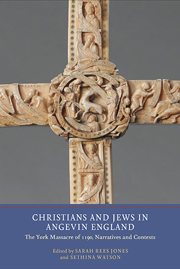Book contents
- Frontmatter
- Contents
- List of Illustrations
- Contributors
- Editor's Preface and Acknowledgments
- Abbreviations
- Introduction: The Moment and Memory of the York Massacre of 1190
- Part I The Events of March 1190
- Part II Jews among Christians in Medieval England
- 6 Faith, Fealty and Jewish ‘infideles’ in Twelfth-Century England
- 7 The ‘Archa’ System and its Legacy after 1194
- 8 Making Agreements, with or without Jews, in Medieval England and Normandy
- 9 An Ave Maria in Hebrew: the Transmission of Hebrew Learning from Jewish to Christian Scholars in Medieval England
- 10 The Talmudic Community of Thirteenth-Century England
- 11 Notions of Jewish Service in Twelfth- and Thirteenth-Century England
- Part III Representations
- Afterword: Violence, Memory and the Traumatic Middle Ages
- Bibliography
- Index
- York Medieval Press: Publications
7 - The ‘Archa’ System and its Legacy after 1194
from Part II - Jews among Christians in Medieval England
Published online by Cambridge University Press: 05 May 2013
- Frontmatter
- Contents
- List of Illustrations
- Contributors
- Editor's Preface and Acknowledgments
- Abbreviations
- Introduction: The Moment and Memory of the York Massacre of 1190
- Part I The Events of March 1190
- Part II Jews among Christians in Medieval England
- 6 Faith, Fealty and Jewish ‘infideles’ in Twelfth-Century England
- 7 The ‘Archa’ System and its Legacy after 1194
- 8 Making Agreements, with or without Jews, in Medieval England and Normandy
- 9 An Ave Maria in Hebrew: the Transmission of Hebrew Learning from Jewish to Christian Scholars in Medieval England
- 10 The Talmudic Community of Thirteenth-Century England
- 11 Notions of Jewish Service in Twelfth- and Thirteenth-Century England
- Part III Representations
- Afterword: Violence, Memory and the Traumatic Middle Ages
- Bibliography
- Index
- York Medieval Press: Publications
Summary
On 17 March 1190, as the ash turned to dust at the top of the motte which is now known as Clifford's Tower, the government knew that it had lost control and would have to react to the spoliation of the York Jewry. In the first case a riot had taken place and this did not please the new king, Richard I, and could not go unnoticed or unpunished. In the second case, because of the profits the crown drew from Jewish money lending, the government needed to put a system in place to protect its income from Jewish lending, particularly in York. The unique solution to the latter marked a major step forward in the development of medieval commerce. The punishment came swiftly.
The response to the second problem, that of protecting Jewish money lending, took the government a little longer to solve and, when it came, the repercussions were national rather than local. In September 1194, itinerant justices were sent around the country to reclaim and reorganize royal rights. Howden claimed that one of their briefs was to record in writing all lands, houses, rents and possessions of the Jews. They were also to provide six or seven places in which the Jews should deposit all their contracts and to appoint officials, two Jewish, two Christians and two scribes before whom all contracts were now to be made. It is widely accepted that the Ordinances of the Jewry were the brainchild of Hubert Walter.
- Type
- Chapter
- Information
- Christians and Jews in Angevin EnglandThe York Massacre of 1190, Narratives and Contexts, pp. 148 - 162Publisher: Boydell & BrewerPrint publication year: 2013



